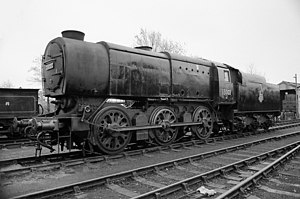SR Q1 class
| SR Q1 class | |||||||||||||||||||||||||||||||||||||||||||||||||
|---|---|---|---|---|---|---|---|---|---|---|---|---|---|---|---|---|---|---|---|---|---|---|---|---|---|---|---|---|---|---|---|---|---|---|---|---|---|---|---|---|---|---|---|---|---|---|---|---|---|

Sole-preserved Q1 no. 33001, seen here at Sheffield Park
|
|||||||||||||||||||||||||||||||||||||||||||||||||
|
|||||||||||||||||||||||||||||||||||||||||||||||||
|
|||||||||||||||||||||||||||||||||||||||||||||||||
|
|||||||||||||||||||||||||||||||||||||||||||||||||
|
|||||||||||||||||||||||||||||||||||||||||||||||||
| Type and origin | |
|---|---|
| Power type | Steam |
| Designer | Oliver Bulleid |
| Builder |
|
| Build date | 1942 |
| Total produced | 40 |
| Specifications | |
|---|---|
| Configuration: |
|
| • Whyte | 0-6-0 |
| • UIC | C h2 |
| Gauge | 4 ft 8 1⁄2 in (1,435 mm) standard gauge |
| Driver dia. | 5 ft 1 in (1.549 m) |
| Length | 54 ft 10.5 in (16.73 m) |
| Total weight | 89 long tons 5 cwt (199,900 lb or 90.7 t) 90.7 t; 100.0 short tons |
| Fuel type | Coal |
| Fuel capacity | 5 long tons 0 cwt (11,200 lb or 5.1 t) 5.1 t; 5.6 short tons |
| Water cap | 3,700 imp gal (16,800 l; 4,440 US gal) |
| Firebox: • Firegrate area |
27 sq ft (2.51 m2) |
| Boiler pressure | 230 lbf/in2 (1.59 MPa) |
| Heating surface | 1,472 sq ft (136.75 m2) |
| • Tubes and flues | 1,302 sq ft (120.96 m2) |
| • Firebox | 170 sq ft (15.79 m2) |
| Superheater: |
|
| • Heating area | 218 sq ft (20.25 m2) |
| Cylinders | Two, inside |
| Cylinder size | 19 in × 26 in (483 mm × 660 mm) |
| Valve gear | Stephenson |
| Valve type | Piston, outside admission |
| Valve travel | 6 1⁄8 in (155.58 mm) |
| Valve lap | 1 5⁄8 in (41.28 mm) |
| Performance figures | |
|---|---|
| Tractive effort | 30,080 lbf (133.80 kN) |
| Career | |
|---|---|
| Operators | |
| Class | SR: Q1 |
| Power class | BR: 5F |
| Numbers |
|
| Withdrawn | 1963–1966 |
| Disposition | One preserved, remainder scrapped |
The SR Q1 class is a type of austerity steam locomotive constructed during the Second World War. The class was designed by Oliver Bulleid for use on the intensive freight turns experienced during wartime on the Southern Railway network. A total of 40 locomotives were built. Bulleid incorporated many innovations and weight-saving concepts to produce a highly functional design. The class lasted in service until July 1966, and the first member of the class, number C1, has been preserved by the National Railway Museum.
The highly unusual and controversial design represents the ultimate development of the British 0-6-0 freight engine, capable of hauling trains that were usually allocated to much larger locomotives on other railways. Nicknames for the class included "Ugly Ducklings", "Coffee Pots" and "Charlies".
In late 1939, the Southern Railway, until then primarily a high-density commuter railway serving London and South-East England, much of it electrified with third-rail pick-up, found itself on the British front line of the Second World War, with a severe lack of modern freight-handling capability. The newest freight design was the Q Class 0-6-0 of 1938, the last locomotive designed by Richard Maunsell. Built to essentially Victorian era principles, these had been designed as replacements for many of the older 0-6-0s inherited by the Southern Railway in 1923, and entered service in January 1938. Maunsell, having retired at the end of October 1937, was replaced by Oliver Bulleid.
The Southern Railway, therefore, became an essential strategic war-asset because of its proximity to continental Europe, and needed to equip itself with adequate freight-handling capability to transport the vast quantities of supplies and troops required for the conflict. The brief stipulated high route availability and high tractive effort.
The answer to this problem came from the drawing board of the Southern Railway's innovative Chief Mechanical Engineer, Oliver Bulleid in the shape of the Q1. Using the minimum amount of raw materials, and with all superfluous features stripped away, he produced in 1942 the most powerful 0-6-0 steam locomotive ever to run on Britain's railways. The first twenty locomotives were constructed at Brighton works and the remaining twenty at Ashford. Powerful and light, the Q1s formed the backbone of the Southern's heavy freight capability. The engine weighed less than 90 tons (90.6 tonnes) so could be used over more than 97% of the Southern Railway's route mileage.
...
Wikipedia
